By Nicholas Drummond and Jed Cawthorne
In a world where wheeled armoured vehicles are becoming the primary equipment type for all NATO armies, this article explores the development and increasing importance of the All-Terrain Transport Vehicle (ATTV) in providing mobility when extreme terrains are encountered.
Boxer can do most things, but not everything
The British Army is justifiably excited about the imminent arrival of the Boxer multi-role armoured vehicle. This will replace ageing and worn-out MRAPs as well as the FV432 APC, a vehicle approaching 60 years of service life. As other articles make clear, Boxer will be a step-change in capability by combining operational mobility with tactical mobility. (Operational mobility is a vehicle’s ability to travel from the theatre entry point to the area of combat operations; tactical mobility is a vehicle’s agility within the area of combat operations). Boxer offers these benefits thanks to its advanced 8×8 driveline which gives it excellent off-road performance for a wheeled vehicle as well as a rapid on-road performance in excess of 100 kph for the self-deployment of mechanised infantry. In most situations, Boxer will arrive long before tanks and other tracked AFVs. It will also go wherever MBTs and tracked IFVs go. However, wheeled units are likely to encounter extreme terrain that not only challenges the Boxer’s off-road abilities, but even those of Challenger 2 and Warrior.

With future combat operations expected to take place in built-up areas this may not matter. For fighting in the streets of megacities or suburban areas, wheeled vehicles are preferable. They’re faster, quieter and easier to move. They also cause less damage to road surfaces. Tracked AFVs are noisy and difficult to manoeuvre. Turning on their own axis can rip-up paved surfaces or they can get stuck in narrow streets. For these reasons, many armies are moving to predominantly wheeled fleets. But what about deployments to areas with extreme terrain? Although extreme terrain scenarios are unlikely, they are not impossible and the Army must be resourced to operate across a range of scenarios and climatic conditions. Fighting on NATO’s Northern flank in winter, in deep snow, is likely to be difficult for wheeled platforms, if not impossible. Swamps and marshland will also present an obstacle as will other very soft soil conditions. In arid deserts, fine sand may prevent a vehicle’s tyres from gaining traction while the overall weight of vehicle will prevent it from climbing steep inclines.
The Hagglunds Bandvagn family of ATTV vehicles
The Swedish vehicle manufacturer Hagglunds anticipated the extreme terrain mobility problem as long ago as the mid-1960s when it developed the Bv 202 All-Terrain Transport Vehicle (ATTV). Originally acquired by the Swedish Army so that it could negotiate snow and marshland areas, the Bandvagn has been subsequently acquired by a variety of NATO alliance members, including the UK. The Bv 202 was primarily used as a logistics carrier, but its potential as a troop carrier was soon realised and the platform was modified.
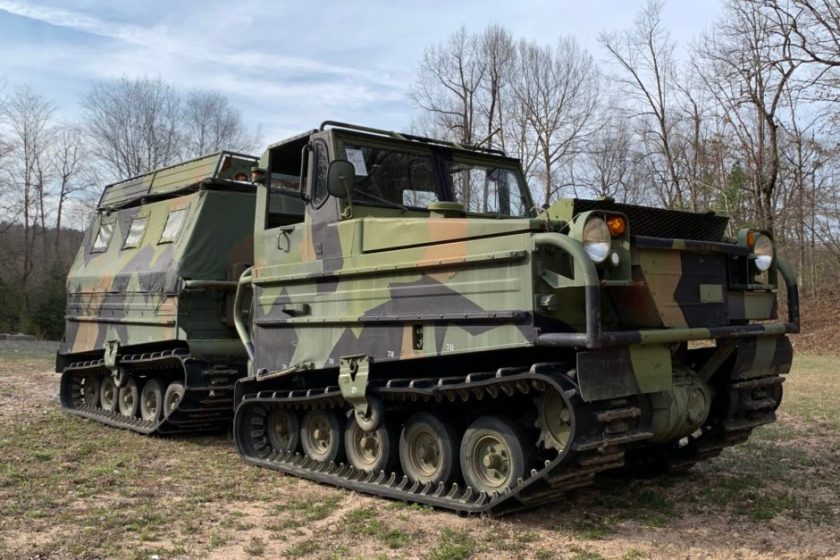
The original Bv 202 platform received an extensive re-design in 1980 when the Bv 206 was introduced. This built on the capabilities of its smaller, older brother by offering increased payload and performance in a larger package. In essence, the Bv 202 and Bv 206 evolved into all-terrain personnel carriers with articulated twin cabs. Weighing less than 7 tonnes they can be underslung beneath a Chinook. They have an extremely low ground pressure and are amphibious making them ideal for maritime operations. The Royal Marines acquired around 350. The only obvious disadvantage was limited survivability due to a lack of protection.
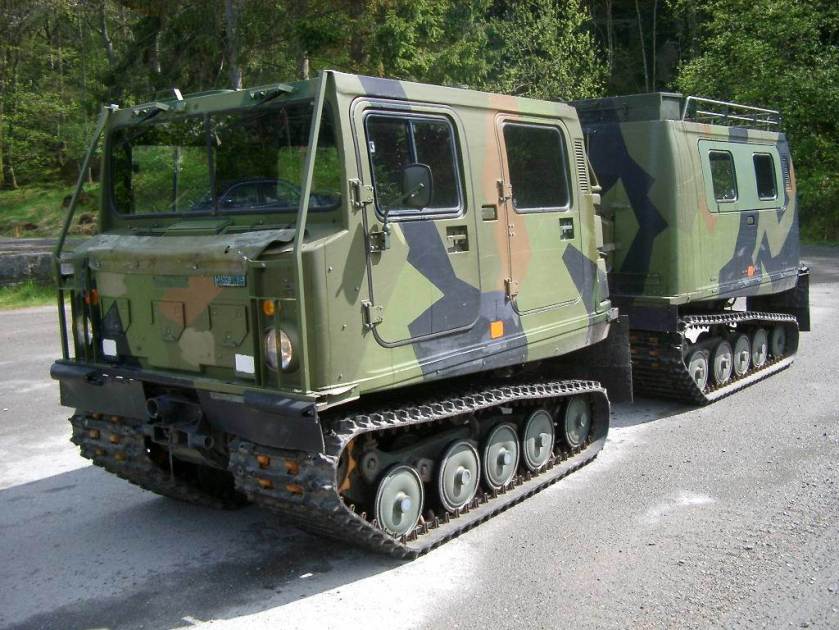
The Bv 206 ATTV was superseded by a further improved vehicle, the BvS 10, in 2004. This was a collaboration between between Hagglunds (now owned by BAE Systems) and the UK Ministry of Defence; and was called Viking in UK service. The major improvements were the addition of armoured protection, increased ground clearance, a more powerful driveline, and increased speed on the ground and in water. The platform also became more modular allowing it to incorporate a variety of mission fits. The Royal Marines acquired 108 vehicles in four versions: a Troop Carrying Variant (TCV); Command Variant (CV); Repair & Recovery Variant (RRV); and an Ambulance Variant (AV). The vehicle has 2 crew members in the forward cab and can carry 8-10 passengers in the rear compartment.

For use in Afghanistan, bar armour was added to the exterior. Although characterised by rough terrain, the vehicle saw service more as a regular personnel carrier than an extreme off-road platform. There was just one problem. Although the Viking was now protected, it did not have sufficient armour to cope with the burgeoning IED threat. Several Vikings were destroyed by large IEDS creating a crisis of confidence in the vehicle. Less than two years after being introduced into service, the UK Ministry of Defence was forced to supplement the Viking fleet with ST Kinetics’ own version of the same type of platform, the Bronco All-Terrain Tracked Carrier. Dubbed Warthog in UK service, around 100 were acquired. Several survived IED attacks, including one that was hit by a 50 kg device. While the Warthog offered increased protection, early versions were not amphibious. Moreover, being hurriedly acquired through an Urgent Operational Requirement (UOR) purchase, the platform proved to be less mechanically reliable than Viking, but this may have had something to do with only limited spare parts and support services being purchased as part of the package. After UK troops left Afghanistan, Warthog was retired and BAE received a contract to refurbish existing Viking Mark 1s to a Mark 2 standard,[1] which included adding additional armour. Thereafter, the fleet was returned to Royal Marine service with a few being retained by the Army for STA roles.
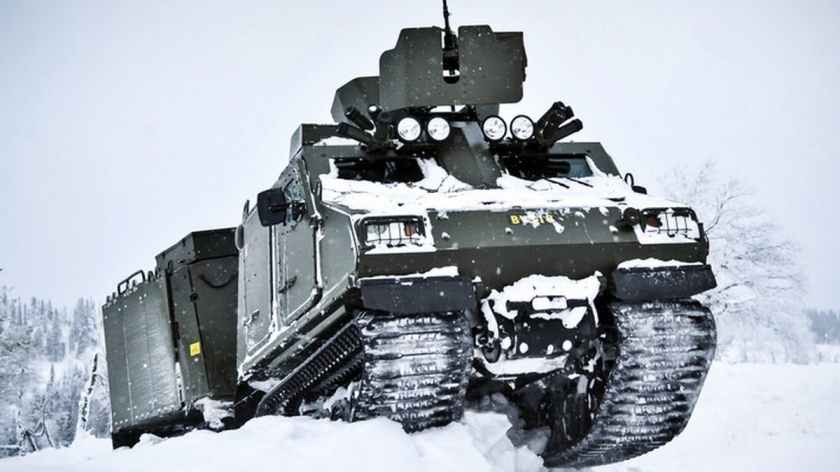
The Royal Marines are now considering what should replace both the Bv 206 and BvS 10 via the Future All-Terrain Transport Vehicle (F-ATTV) programme. Various options are being considered. It is presumed that a further development of the BvS 10, a Mark 3 version might be offered as well as the ST Kinetics Bronco 3, a new version of the platform used by the UK in Afghanistan. A further option could be something like the Amphibious Combat Vehicle (ACV), which is based on the IVECO SuperAV. This is being acquired by the United States Marine Corps, but since it is an 8×8 platform, it is likely to suffer from the same mobility issues as Boxer across extreme terrains. For this reason a tracked solution may be preferable.
Could a new version of the BvS 10 / F-ATTV also fulfil MRV(P) roles?
Beyond replacing the existing BvS fleet, a new ATTV platform could offer wider utility across other protected mobility roles. The UK Ministry of Defence is concurrently running three other vehicle acquisition tenders via the Multi-Role Vehicle (Protected) programme. This is divided into three packages. MRV(P) Package One is for a Command and Liaison Vehicle (CLV) and Tactical Support Vehicle (TSV) with a single vehicle type replacing Panther and Husky respectively. MRV(P) Package Two is for a single vehicle type to perform Battlefield Ambulance (BFA) and Troop Carrying Vehicle (TCV) roles replacing the Land-Rover Ambulance and Mastiff MRAP respectively. MRV(P) Package Three is a requirement for a new Light Weight Recovery Vehicle (LWRV).
The key question is whether a new version of the BvS 10 could supplement the MRV(P) fleet by fulfilling requirements across four roles?
- Command and Liaison Vehicle (CLV)
- Tactical Support Vehicle (TSV)
- Troop Carrying Vehicle (TCV)
- Light Weight Recovery Vehicle (LWRV)
If a new version of the BvS 10 were developed for the above roles, it would need to combine increased protection (including a V-shaped hull). However, the BvS 10 Mk 2 already meets the STANAG 4569 Level 2 standard set for MRV(P), so it may be fit for purpose unchanged. It would also need the ability to mount a variety of weapons as well as an amphibious capability that isn’t compromised by any armour upgrades. The modular nature of the platform allows a variety of systems to be fitted. The Royal Marines have an 81 mm mortar version, while Patria has already proposed a BvS 10 with its NEMO 120 mm mortar system. A remote weapon stations with a light cannon (e.g. the Northrop Grumman 30×113 mm M230LF chain gun) plus a Javelin ATGM launcher would provide a welcome boost to platform lethality.

A protected ATTV with tracks for the MRV(P) role would likely be more expensive than a wheeled vehicle like Bushmaster, but would be much more flexible. The BvS 10 performs well in Norwegian snow, or when negotiating beeches with wet sand, shingle or steep exits, but how good is it on tarmac? Since the MRV(P) fleet will spend most of its time on roads, a GP ATTV would need to be suitable for long road deployments carrying mechanised infantry battalions. Could an ATTV ever provide operational mobility?

The answer is “yes.” This is because both Viking and Bronco utilise Composite Rubber Tracks (CRT). Developed by Soucy Defense,[2] CRTs are continuous single-piece banded tracks with exceptional strength and durability. They allow tracked vehicles to perform well on-road and across rough terrain. Typical track lifecycles are above 5,000 km, which is vastly superior to the metal link tracks used by most legacy AFVs. Composite Rubber Track (CRT) do not have rubber pads that need to be replaced, they don’t damage road surfaces, and, if damaged, a battlefield repair kit allows a break to be patched-up so that a vehicle can return to base under its own steam. The CRTs fitted to Viking and Bronco enable them to maintain on-road speeds of above 60 km/h while having a range of 400-500 kilometres. They can certainly cope with long road deployments better than Ajax, Warrior or Challenger 2.

While the BvS 10 can perform longer road marches than many legacy tracked platforms, the question is whether its overall specifications can be improved to enable 1,000 km road deployments? To further enhance their on-road performance, Viking and Bronco would need rubber-rimmed road wheels and an improved suspension system, to dampen noise and vibration and increase ride comfort. They would also need larger fuel tanks for extra range and a more powerful driveline to enable higher road speeds and to cope with additional weight. Increasing their capabilities is likely to raise gross vehicle weight. The need for low weight so that a vehicle is agile across rough terrain and with sufficient buoyancy to remain amphibious in high sea states, conflicts directly with the opposite requirement for increased protection that adds mass. However, the advantage of an articulated vehicle configuration is that it distributes total weight over two sets of tracks, offsetting weight gains relative to conventional armoured vehicle configurations.
A decade ago, ATTVs were a niche capability. Today, there have become a mainstream military vehicle type. The following factors makes a new CRT-equipped ATTV viable and desirable:
- The BvS 10 Viking Mk2 is already in service and would be easy to upgrade further
- The STK Bronco has also been in service with the UK, while the Bronco 3 is likely to meet many UK F-ATTV requirements
- BvS 10 is in use with various allies including France (with whom we have various expeditionary agreements) and the Netherlands (whose Marines work closely with ours)
- Various allied nations have outstanding requirements for more, similar vehicles, many to replace existing fleets of soft skinned Bv 206, including the US Army which had a large number of Bv 206 variants
- Articulated ATTV’s by their design nature are highly modular; this means many of the existing components used in both Viking and Bronco could be used in a future platform reducing through-life support costs
- The BvS 10 family includes protected and un-protected (Beowolf) variants
- The Bronco family includes protected and un-protected (ExtremV) variants
If a substantial quantity was purchased, potentially through a shared multi-national contract among several NATO members, this could provide attractive economies of scale. The price differential between a tracked ATTV and a conventional wheeled platform could be reduced to the point where the ATTV would not be significantly more expensive.
Additional benefits of increasing the ATTV fleet size…
With 523 Boxers being acquired, this platform will only partially replace the FV 432 family. Introduced in 1963, this diesel-powered box on tracks has far exceeded its intended service life. Although modestly updated throughout its service life, it is now seriously showing its age. Approximately 800 FV432 Mk2 Bulldog’s remain service, so unless more are acquired Fv432 will need to soldier on. While more Boxers is highly desirable, an ATTV could also usefully substitute the FV432.
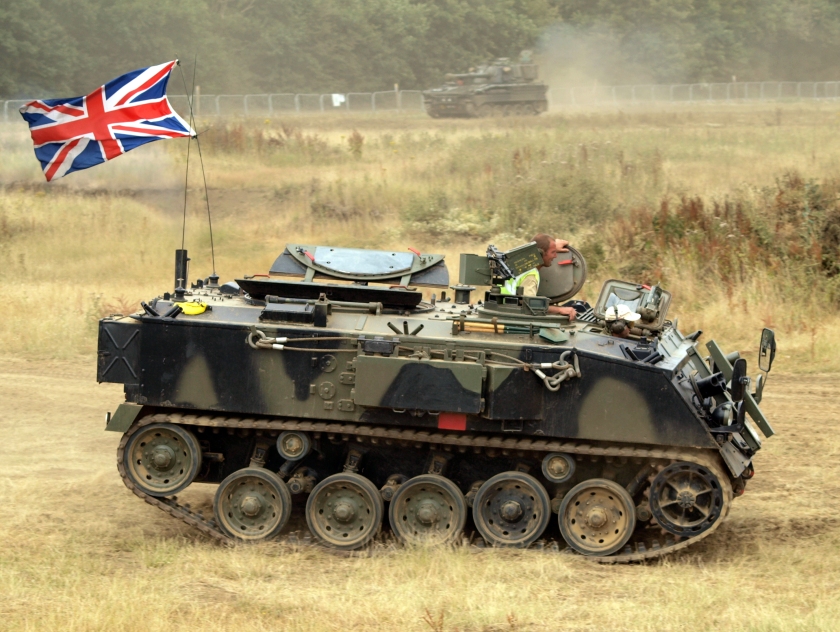
If 300-400 ATTVs were acquired, this would be enough to equip an entire rapid response high mobility brigade and could reduce the need for wheeled Protected Mobility vehicles. While JLTV plus Bushmaster or Eagle would replace the MRAP fleet (Mastiff, Ridgeback and Wolfhound, Land-Rover Ambulance and Foxhound), like Boxer, they suffer from the same extreme terrain limitations. So a larger ATTV fleet would complement MRV(P) for units where mobility was a priority.
Additional ATTVs would be needed for CS and CSS roles. So an entire brigade could be resourced with 500-600 vehicles. Add the Royal Marine requirement for 300-400 vehicles and the total requirement could be over 1,000 vehicles. The commonality of spare parts, logistics, maintenance and operational training across Army and RM versions could lead to worthwhile economies of scale.
A suggestion for an affordable approach to protected mobility
For MRV(P) Package 2, a large purchase of either the Bushmaster or Eagle, would meet the requirements for larger numbers of protected vehicles for many units. As discussed elsewhere, reconfiguring the existing Jackal and Foxhound fleets could achieve the same effect at a lower cost. Beyond this lighter end of the protection spectrum, we could either continue with separate heavy mechanised forces with Ajax, Warrior 2 and eventually a Challenger 3; or we could replace Warrior with Boxer and support our MBT’s with an all-wheeled AFV force like the French have done for a decade. Whatever we do, we will need a protected mobility solution for delivering infantry “mass.”
The Army, for budgetary reasons, has been forced to organise its brigades in pairs: two heavy tracked Armoured Brigades, and two mostly wheeled Strike (Mechanised) Brigades. If there were two Boxer-equipped Mechanised Infantry Battalions in each of the Armoured Brigades, and three Boxer battalions in each of the Mechanised Brigades, that would provide a total of 10 battalions out of total of 31 regular infantry battalions with protected mobility. Notwithstanding personnel constraints, we should be able to generate six further battalions to create two Light (Protected Mobility) Infantry Brigades with each brigade having thee infantry battalions. Equipping one of these brigades with an ATTV (either BVS10 Mk2 Viking or Bronco Mk3) would provide a considerable uplift in flexible protected mobility platforms. Based on the UK LandPower article on a standardised Infantry battalion structure based on a 36 person platoon, the cost might not be prohibitive as only 3 (rather than 4) ATTV’s would be required to carry 36 troops. This could break down into three 12-soldier rifle sections, each with two vehicle crew (driver and vehicle commander / gunner per vehicle) and a 10-soldier section. Combat Support (CS) and Combat Service Support (CSS) units could be equipped with appropriate variants, as would the supporting units of heavy tracked mechanised brigades, replacing their FV432s.
ATTVs could be used by Parachute Regiment battalions of 16 Air Assault Brigade, especially if they were air-droppable by A400M. Light, highly mobile, protected against mines, IEDs, small arms fire and shrapnel, such vehicles would be ideal for use in places such as the Falkland Islands, mountain regions, remote areas without roads, arctic climes, bogland, deserts, and other extreme environments. For these reasons, a protected ATTV fleet would provide an extra string to the British Army’s bow, providing utility in the rare situations where Boxer is not ideal, but supporting the wheeled fleet in all situations.
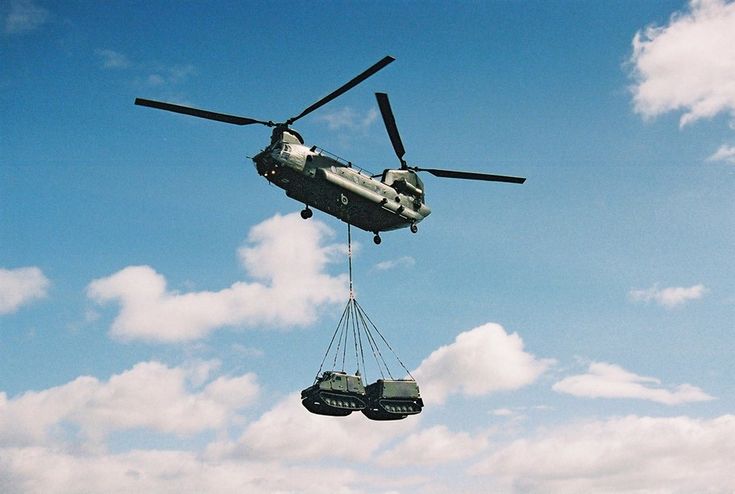
[1] https://www.baesystems.com/en/article/bae-systems-to-carry-out-pound38m-royal-marines-bvs10-viking-regeneration
[2] http://www.soucy-defense.com/military-rubber-track-applications/military-rubber-track-application-vehicles-under-25-tonnes
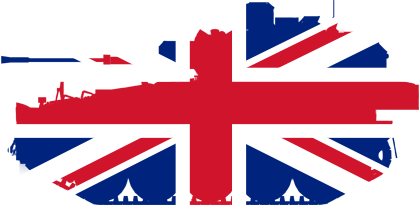



Thanks for the article. One of the negatives I have read when the Viking or Bronco type vehicle has been proposed in the past as a APC is its relatively large turning circle and the importance of this for example on a narrow road in a built up area. Whereas a non articulated tracked APC can turn on access. Is this a valid criticism?
LikeLike
If both (the front and the back cabin) are linked together the turning circle can be an problem. But at least the latest versions of the bronco offer the possibility to undock both and move them independendly. The front vehicle can then move for its own and can then turn on the access. Some have suggeested to build an recon tank out of this vehicle because of its superior mobility.
One argument for the bronco is also imo that it can transport 16 soldiers (6 in the front vehicle including the driver and 10 in the back cabin). This would enable units of good size without to much vehicles and would therefore decrease the effort for transportation for infantry units very much and would decrease their size or increase the boots on the ground with the same size.
For example transporting 64 infantry in gtk boxer needs 8 vehicles (8 soldiers per vehicle) and to this are added at least 2 soldiers per boxer for an overall size of for 80 men.
This whole company could be transported in only 5 Bronco (5 x 15 soldiers for an overall of 75 infantry and 5 drivers).
You would spare 3 vehicles per company and would increase the number of infantry for 11 additonal infanrymen.
If you think now about complete bataillons and brigades this changes much.
LikeLike
Ulrich
I think your numbers for crew / pax are based on Bronco mk1. The STK brochure for the new Bronco Mk3 states 12 total – 4 in front module, 8 in the back.
Click to access bronco.pdf
LikeLike
Mike
Turning circle might be a valid criticism as it might be real issue, however I have no operational experience on Viking or Bronco so I can’t really say. I guess the RM Armoured Support Group would be able to opine on that w8th respect to official requirements, but I simply don’t know !
LikeLike
Jed:
You are right, the latest version is “only” 12 but this changes nothing that 12 is still an tremendous advantage in numbers – especially if you look at whole formations of upper echelons.
One thing i did not mentioned is, that you can also add an trailer for additional load behind such vehicles.
I wonder if it would be possible to add also an third module and construct the vehicles so, that you can split them and move all modules seperate as this is possible for the latest verson of the bronco.
This offers also additional possibilities as you could then use such an module as an kind of UGCV and control it from the other modul from an distance. My idea would be to install the LOS/NLOS Weapons (like for example an 105mm Hawkeye Howitzer or for example new generation ATGM) on one module and then you can move the module and fire the weapons from the other module. This could be very interesting option because enemy action against the module would not cost any soldiers lives and you would also not loose the complete vehicle and could act with more risk.
LikeLike
Great article to this seems a great idea to have efficient fleets and give the army a niche capability. Considering distances the ATTV would need to deploy the Bronco 3 would probably be my choice as it likely to have a better payload capacity and space for troops.
Considering the changes to RM commandos lately I can’t see something like the ACV fitting in for F-ATTV. TBH in the future I can see RMs doing limited theatre entry and then deploying strike brigades as the main land component of an amphibious operation (hopefully increasing the use of LSDs and point class)
I can’t really understand the Warthog decision as retaining the vehicle seemed ideal for reinforcement of the northern flank and possibly creating a mountain support formation.
The article also raises 2 questions:
1. Why seemingly are there currently no plans to get CRT on to the Strike Ajax platform as surely this could solve it’s strategic Mobility?
2 is Boxer really the correct solution for FV432 replacement? On cost grounds alone a ATTV would be a lot more affordable as would something such as patria 6×6, reconditioned turretless Warriors or potentially FFG G5 PMMV
Boxer is a hugely capable and expensive platform to be doing back of the line duties I’d rather dedicate them to Strike.
I am also a fan of something like patria 6×6 or VAB type performing MRVP 2 combat roles with MRVP 1 being a merger of 1 4×4 & 6×6 type to provide the support capabilities of MRVP 2 as to me this would give troops direct combat support greater protection and mobility to keep up with Boxer & Ajax, whilst potentially still affordable and retaining a 3 fleet solution.
LikeLike
Simon M,
Composite Rubber Tracks (CRT) rated to 50 tonnes have only just become available. In fact, early prototypes were tested on Warrior and performed exceptionally well. According to ATDU, it is only a matter of time before CRTs are adopted widely by British Army combat vehicles. We won’t see them on Ajax until hull and suspension issues are resolved. While Soucy Defense is the clear market leader in CRTs at this time, other firms are starting to produce them. While Soucy has gone for a continuous single track, others are looking modular systems with multiple links.
I believe Boxer is the correct solution to replace the FV432 family, because operational mobility has become so important. Moreover, Boxer really can go just about anywhere a tracked equivalent can go. It only really gets into trouble in deep snow, marshland and very soft soil. Boxer can also enter the direct fire zone whereas BvS 10 cannot.
Having worked with Patria for several years, I am obviously a big fan of both the 6×6 APC and 8×8 AMV. Ultimately, a mix of Boxer and Bushmaster or Eagle for the protected mobility fleet is a good one. My choice for MRV(P) would be Bushmaster. This is an extremely capable platform that ticks so many boxes including cost.
Ultimately, our combat vehicle fleet will be streamlined to just eight platforms:
1. Challenger 3 MBT
2. Ajax CRV
3. Warrior IFV
4. Boxer MIV
5. MRV(P) JLTV CLV/ TSV
6. MRV(P) Bushmaster or Eagle BFA/ TCV
7. BvS 10 ATTV
8. Jackal/ Coyote HMT
It could be as few as seven because having both Ajax and Warrior doesn’t make sense.
LikeLike
Many thanks for the reply and apologies for tardy response . I bow to your greater knowledge over boxer/fv432 replacement. Probably just a bit of OCD on my account wanting all tracked formation as STRIKE probably should be all wheeled.
I still think the fleet could be streamlined further by adopting HMT for MRVP 1 & 2. I wish supacat would invest in closed cab 4×4 & 6×6 ambulance/troop transport to demonstrate what it could do. Do you think an Ajax IFV is still a possibility? To replace warrior? Or would that be Boxer again? Would common sense be to reduce Ajax recce purchase & reconfigure remaining purchase as IFV with unmanned turret or slightly extended with cta manned turret?
Then Ajax recce turrets to Boxer module.
Is there any reason as to why BVS10 and not Bronco 3 the latter seems to have better payload?
LikeLike
TotherChris raised the possibility of Bronco 3 replacing FV432 a while back, I remember remarking on the simple genius of it at the time and make a point of reading him now.
I don’t think we can afford to be in the business of building bespoke brigades, the situation is too dire, as I suggested an 8×8/6×6 solution to strike, so I’d suggest that the Armoured Infantry consider Bronco 3 its 6×6, realistically you could look at tier1 and tier2 (or support if you like) elements to your battalions , probably somewhere in the 70/30 range, with the tier 2 addressing command, mortar, ambulance, logistics etc, etc, in the case of strike this probably puts you somewhere near a triangular strike division for largely equivalent Boxer numbers, (a point I think Gabriele is currently making as he again takes a mallet to it) and pushes you toward an armoured division hopefully restoring the rule of three.
I’m going to ignore the no front line argument basically on budgetary grounds but also because I’ve just watched the Forces TV piece: Strike Brigade and have learned that we’re going to win by thinking better than the enemy, so I’m comforted by that fact.
I’m largely in agreement with TD’s ‘bulging out the middle’ article and would like to see us progress to two mechanised divisions occupying the centre of the army, but that can only be done with clarity of purpose.
If it’s a matter of ATTV’s just for their general utility…
“The need for the RMASG came about because the Viking was so successful with 3 Cdo Bde on Op Herrick 5 that the incoming forces on Op Herrick 6 requested that the Vikings stay on creating a problem as the Army has no Viking trained drivers. The solution was the RMASG, an expanded unit that could continue to operate the Viking for future roulements, this led to the drivers of the RMASG having one of the highest operational tempos in the forces”
… then perhaps store the potential elsewhere, if each logistics regiment held a squadron for the last mile then such a capability could be maintained against future need; I’d observe that if each chassis were independently capable then looked at in combination with something like the US MUTT/SMET developments an RLC driver could tow his cargo about as close as he feels comfortable and then send it on its way.
LikeLike
Interesting idea, I would like to see fewer types from fewer manufacturers in service. I think going all Supacat for MRVP, plus Foxhound, would be better than buying JLTV, Bushmaster and having Supacat’s Jackal/Coyote. I agree that replacing Warrior with varians of Ajax would be sensible, and I very much hope that a recce variant of Boxer is the next to be bought so that Ajax can return to AI.
LikeLike
Here is a simple sailors suggestion for a list of combat vehicles for the British Army that gives just 5 generic types with all the benefits of standardisation; and mainly British manufacture. Can we afford it? Can we afford not to?
Conqueror and variants.
Ajax
Ajax, stretched, in lieu of Warrior.
8×8 Boxer.
BvS10 Mk3 ATV
Supacat 600 6×6 MRV(P)
Supacat 400 4×4 MRV(P)
Supacat Jackal, 4×4 HMV
Supacat Coyote 6×6 HMV
LikeLike
I think you mean Challenger 2 not Conqueror?
LikeLike
My main gripe with the BVs10 has always been the steering/ drive system, its so exposed… the amphibious nature of it is amazing.
I am under the opinion that you should build 3 main tracked hulls, Light like for the Bvs10, Medium for troop carriers, AS90 type things and a more dedicated Tank Chassis/ trojan, you spread the costs, and focus developments. Also think of the Logistical nightmare we currently have as a nation fielding SOO many different weapons platforms with different consumable components and im not talking just about tracked systems either, we need to take a page out of the americans and russians play books, Its getting prohibitively expensive to run armies like this, while balancing R&D costs (well… at the current rate of cuts anyway…).
I can guarantee someone is going to mention NATO standardization…. its a consideration not a requirement.
LikeLiked by 1 person
Also Polymers exist. Why not use those on higher Tonnages? the squeak of polymers has got to be quieter than metal pounding the ground?
LikeLike
If you mean by polymers the composite rubber tracks then the struggle to get them on higher ton vehicles is down physics due to heat dissipation caused by friction. Soucy believe they will make 55t in next few years but above that the tracks would need to be very wide the representative seem to indicate any solutions for MBT vehicles would be not in his lifetime
LikeLiked by 1 person